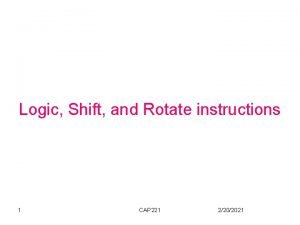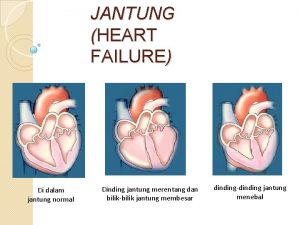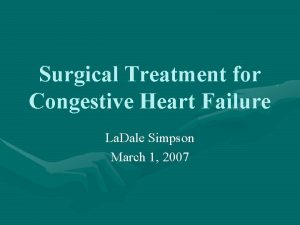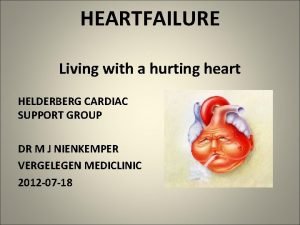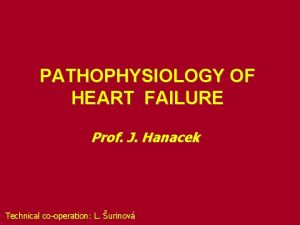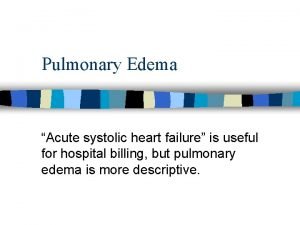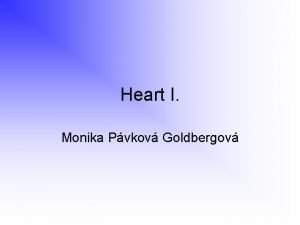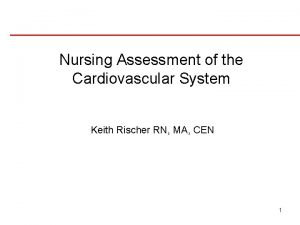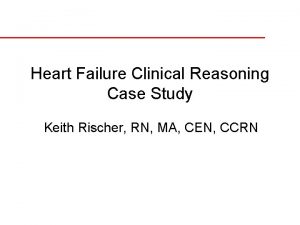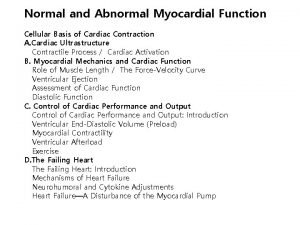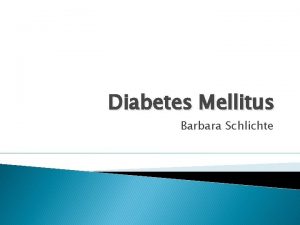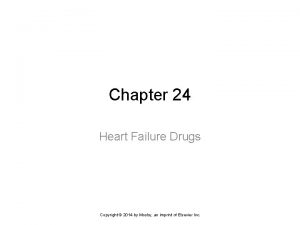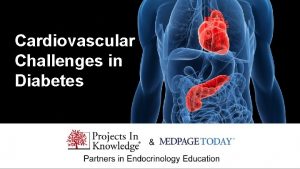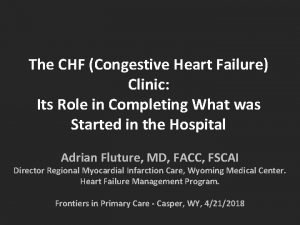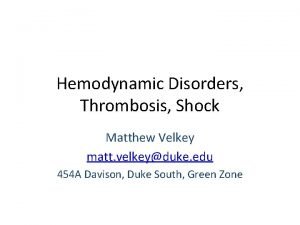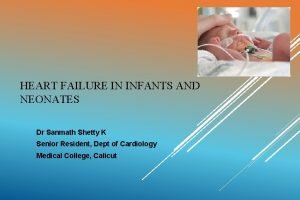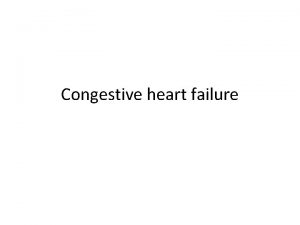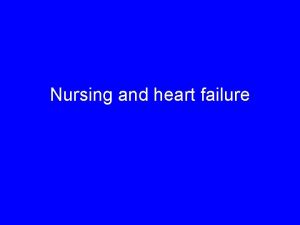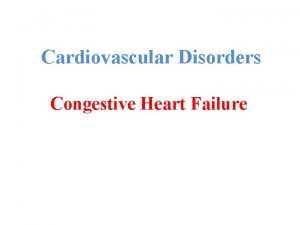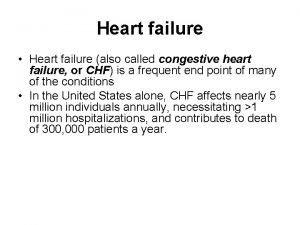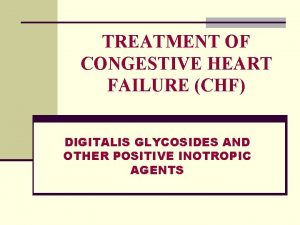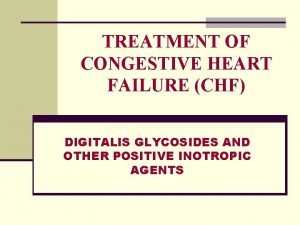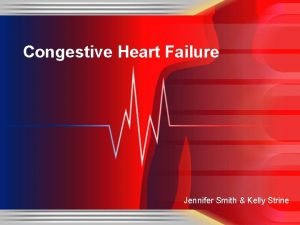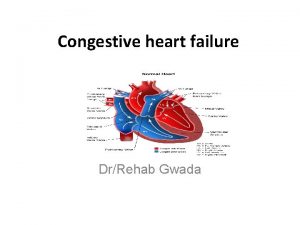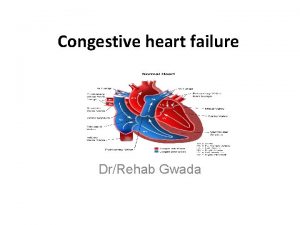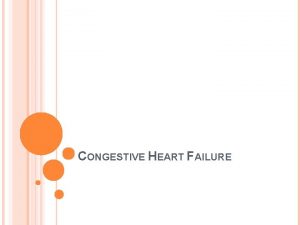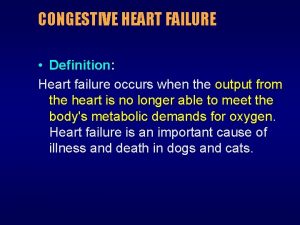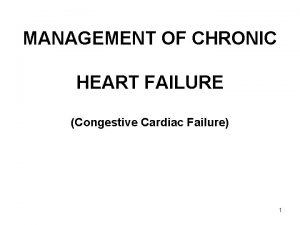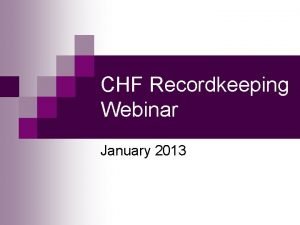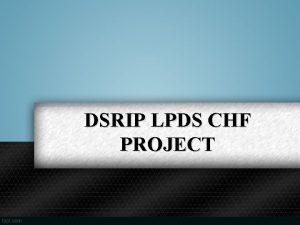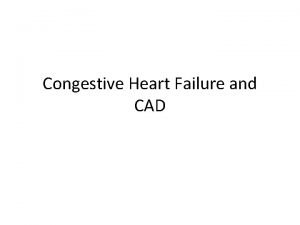HEART FAILURE Congestive heart failure CHF is the














































- Slides: 46

HEART FAILURE

� Congestive heart failure (CHF) is the clinical state of systemic and pulmonary congestion resulting from inability of the heart to pump as much blood as required for the adequate metabolism of the body. � Clinical picture of CHF results from a combination of “low output” and compensatory responses to increase it

PATHOPHYSIOLOGY Tissue demands for cardiac output activates: � Renin-aldosterone angiotensin system � Sympathetic nervous system � Cytokine-induced inflammation � “Signaling” cascades that trigger cachexia.

� Longstanding increases in myocardial work and myocardial oxygen consumption (MVO 2) ultimately worsen HF symptoms and lead to a chronic phase that involves cardiac remodeling

CARDIAC REMODELING Maladaptive cardiac hypertrophy Expansion of the myofibrillar components of individual myocytes (new cells rarely form) � An increase in the myocyte/capillary ratio � Activation and proliferation of abundant nonmyocyte cardiac cells, some of which produce cardiac scarring � Produce a poorly contractile and less compliant heart � �

CLINICAL MANIFESTATIONS IN INFANTS WITH HF � Variety of age dependent clinical presentations � In neonates, the earliest clinical manifestations may be subtle

CLINICAL MANIFESTATIONS IN INFANTS WITH CHF Feeding difficulties q Rapid respirations q Tachycardia q Cardiac enlargement q Gallop rhythm (S 3) q Hepatomegaly q q q q Pulmonary rales Peripheral edema Easy fatigability. Sweating Irritability failure to thrive.

Feeding difficulties & increased fatigability Important clue in detecting CHF in infants q Often it is noticed by mother q Interrupted feeding (suck- rest -suck cycles) q Infant pauses frequently to rest during feedings q Inability to finish the feed, taking longer to finish each feed (> 30 minutes) q Forehead sweating during feeds –due to activation of sympathetic nervous system –a very useful sign q Increasing symptoms during and after feedings

Rapid respirations � Tachypnea > 60/min in 0 -2 mth >50/mt in 2 mth to 1 yr >40/mt 1 -5 yr in calm child � Grunting (a form of positive endexpiratory pressure) � Fever especially with a pulmonary infection may produce rapid respirations.

Tachycardia � � � Rate is difficult to evaluate in a crying or moving child Tachycardia in the absence of fever or crying when accompanied by rapid respirations and hepatomegaly is indicative of HF Persistently raised heart rate > 160 bpm in infants > 100 bpm in older children. Consider SVT if heart rate > 220 bpm in infants and > 180 bpm in older children.

Cardiomegaly � Consistent sign of impaired cardiac function, secondary to ventricular dilatation and/or hypertrophy. � May be absent in early stages, especially with myocarditis, arrhythmias, restrictive disorders and pulmonary venous obstruction(obstructed TAPVC) � Apex 4 th space 1 cm outside MCL in newborn

Hepatomegaly Lower edge of the liver is palpable 1 to 2 cms below right costal margin normally in infancy � In the presence of respiratory infection increased expansion of the lungs displace liver caudally � Usually in such circumstances the spleen is palpable � Hepatomegaly is a sign of CHF � Decrease in size is an excellent criterion of response to therapy �

Pulmonary rales � Of not much use in detecting CHF in infants � Rales may be heard at both lung bases � When present are difficult to differentiate from those due to the pulmonary infection which frequently accompanies failure

Peripheral edema Edema is a very late sign of failure in infants and children � Presacral and posterior chest wall edema in young infants � It indicates a very severe degree of failure. � Daily weight monitoring is useful in neonates -- rapid increase > 30 gm /day may be a clue to CCF and is useful in monitoring response to treatment. �

� Cold extremity, low blood pressure, skin mottling are signs of impending shock � Pulsus alternans (alternate strong and weak contractions of a failing myocardium), or pulsus paradoxus (decrease in pulse volume and blood pressure with inspiration) are frequently observed in infants with severe CHF

CLASSIFICATION NYHA Heart Failure Classification is not applicable � Ross Heart Failure Classification was developed for global assessment of heart failure severity in infants � Modified to apply to all pediatric ages � Modified Ross Classification incorporates Feeding difficulties Growth problems Symptoms of exercise intolerance �

MODIFIED ROSS HEART FAILURE CLASSIFICATION FOR CHILDREN Class I � Asymptomatic Class II � Mild tachypnea or diaphoresis with feeding in infants � Dyspnea on exertion in older children Class III � Marked tachypnea or diaphoresis with feeding in infants � Marked dyspnea on exertion � Prolonged feeding times with growth failure Class IV � Symptoms such as tachypnea, retractions, grunting, or diaphoresis at rest

CAUSES OF HF IN CHILDREN CARDIAC NONCARDIAC Congenital structural malformations ● Anemia ● Excessive Preload ● Sepsis ● Excessive Afterload ● Hypoglycemia ● Complex congenital heart ● Diabetic ketoacidosis disease ● Hypothyroidism No structural anomalies ● Other endocrinopathies ● Cardiomyopathy ● Arteriovenous fistula ● Myocarditis ● Renal failure ● Myocardial infarction ● Muscular dystrophies ● Acquired valve disorders ● Hypertension ● Kawasaki syndrome ● Arrhythmia (bradycardia or tachycardia)

CONGENITAL STRUCTURAL MALFORMATIONS

VOLUME OVERLOAD (EXCESSIVE PRELOAD) Left-to-right shunting VSD PDA AVSD (Atrioventricular septal defect) ASD(rare) Total/Partial Anomalous Pulmonary Venous Connection � AV or semilunar valve insufficiency MR (Mitral regurgitation) after repair of AVSD PR after repair of TOF( Tetralogy of Fallot) Severe TR in Ebstein anomaly �

PRESSURE OVERLOAD (EXCESSIVE AFTERLOAD) � Left sided obstruction Congenital AS Aortic coarctation Lethal arrhythmias - severe afterload stress � Right-sided obstruction Severe PS

CHF (congestive heart failure) WITHOUT CARDIAC MALFORMATIONS NONCARDIAC PRIMARY CARDIAC q Anemia q Cardiomyopathy q Sepsis q Myocarditis q Hypoglycemia q Cardiac ischemia q Acquired valve disorders q Diabetic ketoacidosis q Hypothyroidism q Hypertension q Other endocrinopathies q Kawasaki syndrome q Arteriovenous fistula q Arrhythmia q Renal failure (bradycardia or tachycardia) q Muscular dystrophies

DISORDERS OF CONTRACTILITY Cardiomyopathy is a genetically triggered or acquired disease � Occurs in approximately 1. 13 in 100, 000 children � Characterized by enlarged ventricular chambers and impaired systolic and diastolic function � Usually idiopathic Infection (myocarditis viral-enterovirus) Operative injury Consequence of degenerative or metabolic diseases Muscular dystrophies Mitochondriopathy, Hyperthyroidism carnitine deficiency �

Restrictive cardiomyopathy Idiopathic Infiltrative or storage diseases hemochromatosis Pompe disease Hypertrophic cardiomyopathy � Idiopathic hypertrophic subaortic stenosis, rarely associated with pediatric HF.

TACHYCARDIA Diastolic filling time shortens to and cardiac output is decreased. � Most common childhood tachyarrhythmia is SVT � Often presents in the first few months of life � Rarely cause heart failure � Occasionally Persistent Junctional Reciprocating Tachycardia (PJRT) , ectopic atrial tachycardia and VT �

CHRONIC BRADYCARDIAS � � � LV enlarges to accommodate larger stroke volumes Chamber dilation reaches a limit that cannot be compensated without increase in heart rate Febrile states are particularly stressful Congenital CHB may be well-tolerated in utero Children with congenital CHB who are pacemaker dependent are at risk of subsequent pacemaker-mediated cardiomyopathy

CARDIAC ISCHEMIA � Relatively rare in children � ALCAPA (Anomalous Left Coronary Artery from the Pulmonary Artery � Palliative surgery that requires reconstruction of or near the coronary arteries

LABORATORY STUDIES � PULSE OXIMETRY � ECG � ABG (Arterial Blood Gas)

CXR Size of the heart is difficult to determine radiologically, particularly if there is a superimposed thymic shadow. � Enlarged cardiac shadow unassociated with signs of CHF- suspect that shadow noncardiac � Absence of cardiomegaly in a good inspiratory film (with diaphragm near the 10 th rib posteriorly) practically excludes CHF except due to a cause like obstructed total anomalous pulmonary venous connection (TAPVC) �

CT Ratio method, > 60% Massive cardiomegaly RA dilation Pulm plethora LV Dialatation

ECHOCARDIOGRAPHY � Doppler myocardial performance index � Causes of HF such as structural heart disease � Ventricular dysfunction (both systolic and diastolic) � Chamber dimensions � Effusions (both pericardial and pleural)

PRINCIPLES OF MANAGING HEART FAILURE Recognition and treatment of underlying systemic disease q Timely Surgical Repair of Structural Anomalies Afterload Reduction q ACE ( Angiotensin converting enzyme ) inhibitors q ARB (angiotensin receptor blockers q Milrinone Type 4 phosphodiesterase inhibitors q Nitrates q Recombinant BNP = brain natriuretic peptide q

Preload Reduction q Diuretics q BNP Sympathetic Inhibition q Beta blockers q Recombinant BNP q Digoxin Cardiac Remodeling Prevention q Mineralocorticoid inhibitors Inotropy q Digoxin

MEDICAL THERAPY � Medical management aims to maximize cardiac output and tissue perfusion � Goals are accomplished by reducing afterload stress and preload � Treatments that “rest” the heart such as vasodilators are preferred to inotropic agents that increase MVO 2

GENERAL MEASURES Bed rest and limit activities Nurse propped up or in sitting position Control fever Expressed breast milk for small infants Fluid restriction in volume overloaded Optimal sedation Correction of anemia , acidosis, hypoglycemia and hypocalcaemia if present � Oxygen –caution in LT-RT shunt as pulmonary vasodilation my increase shunt � CPAP (Continuous positive airway pressure) or mechanical ventilation as necessary � � � �


CONGENITAL HEART DISEASE: VOLUME OVERLOAD � General therapeutic approach is to minimize symptoms and optimize growth until a definitive procedure can be performed. � Mainstays of medical therapy are digitalis and diuretics.

DIGITALIS Digitalis considered as essential component � Evidence for efficacy is less in volumeoverload lesions with normal function where the mild inotropic effect of digitalis is unnecessary � Sympatholytic properties may modulate pathological neurohormonal activation �

LOOP DIURETICS � � � Furosemide improved clinical symptoms on a background of digitalis administration Decrease pulmonary congestion and thus decrease the work of breathing It is one of the least toxic diuretics in pediatrics Associated with sensorineural hearing loss after long-term administration in neonatal respiratory distress Deafness related to speed of infusion Torasemide is also safe and effective in this group

ACE (angiotensin-convertingenzyme inhibitors ) Improved growth was seen in some children with CHF � Captopril and enalapril � Concerning incidence of renal failure particularly in premature and very young infants. � No efficacy data on ARB s in children with heart failure �

CARDIOMYOPATHIES � Torasemide, a newer loop diuretic with potassium-sparing properties, significantly improved New York University Pediatric Heart Failure Index, decreased BNP levels, and improved fractional shortening

� Paediatric carvedilol doses 1 mg/kg/day for adolescents 2 mg/kg/day for children aged 2 to 11 years 3 mg/kg/day for infants (aged 28 days to 23 months) � Carvedilol used in many of the studies have been lower than these recommendations

� Treatment of primary diastolic heart failure in children with hypertrophic or restrictive cardiomyopathy are limited to the judicious use of diuretics to decrease the degree of pulmonary congestion.

Inotropes in acute cardiac failure � Routine use of in children cannot be recommended � Used in treatment of exacerbating conditions and as a bridging therapy pending transplantation � Dopamine as it possesses both the cardiac and renal effects is more useful

NUTRITION AND EXERCISE IN PEDIATRIC HEART FAILURE � Important as medical therapy, particularly in infants � Increase the caloric density of feeds as soon as a diagnosis � Sodium restriction is not recommended in infants and young children. � Sodium restriction can result in impaired body and brain growth

� Pacemaker and implantable defibrillator therapy � Biventricular pacing � Ventricular assist devices � Heart transplantation
 Right sided heart failure
Right sided heart failure Congestive heart failure zones for management
Congestive heart failure zones for management Congestive heart failure symtoms
Congestive heart failure symtoms Edema assessment
Edema assessment Rotate instructions
Rotate instructions 5200 chf brut en net
5200 chf brut en net Klasifikasi chf menurut nyha
Klasifikasi chf menurut nyha Chf core measures
Chf core measures Chf-v
Chf-v Types of chf
Types of chf Fracture theory
Fracture theory Failure to capture vs failure to sense ecg
Failure to capture vs failure to sense ecg Failure to pace
Failure to pace Right vs left-sided heart failure chart
Right vs left-sided heart failure chart Compensatory mechanisms of heart failure
Compensatory mechanisms of heart failure Lmnop heart failure
Lmnop heart failure Compensatory mechanism of heart failure
Compensatory mechanism of heart failure Heart failure complications
Heart failure complications Electrical conduction system of the heart
Electrical conduction system of the heart Keith rn heart failure case study
Keith rn heart failure case study Heart failure and frank starling law
Heart failure and frank starling law Diabetes and heart failure
Diabetes and heart failure Chapter 24 heart failure drugs
Chapter 24 heart failure drugs Acute vs chronic heart failure
Acute vs chronic heart failure Donkey analogy heart failure
Donkey analogy heart failure Heart failure defined
Heart failure defined Heart failure definition
Heart failure definition Diabetes and heart failure
Diabetes and heart failure Heart failure
Heart failure Heart failure cells are seen in lungs
Heart failure cells are seen in lungs New york scale heart failure
New york scale heart failure Một số thể thơ truyền thống
Một số thể thơ truyền thống Hệ hô hấp
Hệ hô hấp Các số nguyên tố
Các số nguyên tố Công thức tiính động năng
Công thức tiính động năng Tỉ lệ cơ thể trẻ em
Tỉ lệ cơ thể trẻ em đặc điểm cơ thể của người tối cổ
đặc điểm cơ thể của người tối cổ Các châu lục và đại dương trên thế giới
Các châu lục và đại dương trên thế giới ưu thế lai là gì
ưu thế lai là gì Các môn thể thao bắt đầu bằng tiếng chạy
Các môn thể thao bắt đầu bằng tiếng chạy Thẻ vin
Thẻ vin Tư thế ngồi viết
Tư thế ngồi viết Hát kết hợp bộ gõ cơ thể
Hát kết hợp bộ gõ cơ thể Cái miệng xinh xinh thế chỉ nói điều hay thôi
Cái miệng xinh xinh thế chỉ nói điều hay thôi Từ ngữ thể hiện lòng nhân hậu
Từ ngữ thể hiện lòng nhân hậu Tư thế ngồi viết
Tư thế ngồi viết Trời xanh đây là của chúng ta thể thơ
Trời xanh đây là của chúng ta thể thơ




